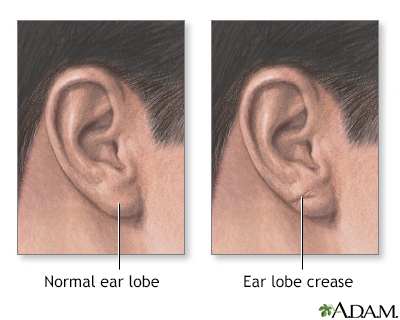Earlobe creases
Earlobe creases are lines in the surface of the earlobe of a child or young adult. The surface is otherwise smooth.

The earlobe in children and young adults is normally smooth. Creases are seldom seen, but when present, they are sometimes associated with rare inherited syndromes.
Considerations
The earlobes of children and young adults are normally smooth. Creases are sometimes linked with conditions that are passed down through families. Other genetic factors, such as race and earlobe shape, may also determine who develops earlobe creasing and when it occurs.
It is not uncommon to have one small abnormality in facial features, such as an earlobe crease. Most often, this does not indicate a serious medical condition.
Causes
In children, earlobe creases are sometimes linked with rare disorders. One of these is Beckwith-Wiedemann syndrome.
When to Contact a Medical Professional
In most cases, the health care provider will notice earlobe creases during a regular checkup.
Talk to your provider if you are concerned that your child's earlobe creases may be linked to an inherited disorder.
What to Expect at Your Office Visit
The provider will examine your child and ask questions about medical history and symptoms. These may include:
- When did you first notice the earlobe creases?
- What other symptoms or problems have you also noticed?
Tests depend on the symptoms and appearance of the earlobe creases.
References
Ali O. Hyperpituitarism. In: Kliegman RM, St. Geme JW, Blum NJ, et al, eds. Nelson Textbook of Pediatrics. 22nd ed. Philadelphia, PA: Elsevier; 2025:chap 598.
Senaratne TN, Zackai EH, Saitta SC. Chromosome disorders. In: Gleason CA, Sawyer T, eds. Avery's Diseases of the Newborn. 10th ed. Philadelphia, PA: Elsevier; 2024:chap 28.
Turnpenny PD, Elard S, Cleaver R. Patterns of inheritance. In: Turnpenny PD, Ellard S, Cleaver R, eds. Emery's Elements of Medical Genetics and Genomics. 16th ed. Philadelphia, PA: Elsevier; 2022:chap 6.
Version Info
Last reviewed on: 10/20/2024
Reviewed by: Neil K. Kaneshiro, MD, MHA, Clinical Professor of Pediatrics, University of Washington School of Medicine, Seattle, WA. Also reviewed by David C. Dugdale, MD, Medical Director, Brenda Conaway, Editorial Director, and the A.D.A.M. Editorial team.
